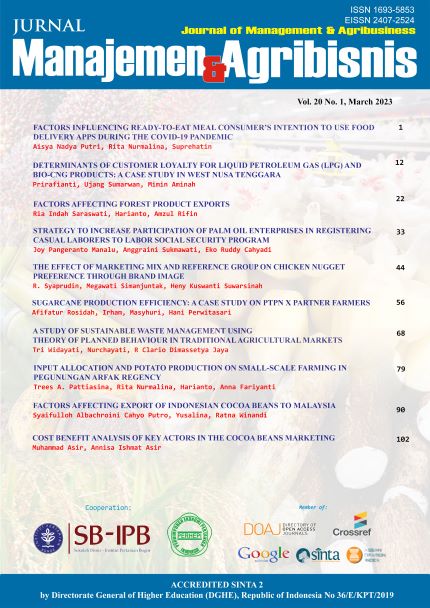Strategy To Increase Participation of Palm Oil Enterprises in Registering Casual Laborers To Labor Social Security Program
Abstract
Many new positions in palm oil plantations and mills are for casual laborers who are particularly vulnerable to poor earnings, lack of social security, and limited legal support. This study purpose is to identify the alternative strategy that can be taken by BPJS Ketenagakerjaan to increase the number of casual laborers in oil palm plantations who enroll in the labor social security program. Purposive sampling is utilized to collect primary data for this study. Respondents are interviewed and given paper-based questionnaires. The respondents are five experts involved in BPJS Ketenagakerjaan's planning and strategy decision-making processes, specifically the Investigating Supervisory Officer (Petugas Pengawas Pemeriksa), Head of Branch Office, Deputy Director of DKI Jakarta Region, Deputy Director for Corporate and Institutional Membership, and Deputy Director for Special Membership. The results of the questionnaire were processed using Expert Choice 11, based on Analytic Hierarchy Process (AHP) as the analytical tool for this study. The results of this study suggest that BPJS Ketenagakerjaan can employ a law enforcement strategy to increase company compliance as an alternative strategy so that casual laborers are able to enroll in the labor social security program.
Keywords: AHP, BPJS Ketenagakerjaan, casual laborers, labor social security, oil palm plantation
Authors
Authors who publish with this journal agree to the following terms:
- Authors retain copyright and grant the journal right of first publication with the work simultaneously licensed under a Creative Commons Attribution License that allows others to share the work with an acknowledgement of the work's authorship and initial publication in this journal.
- Authors are able to enter into separate, additional contractual arrangements for the non-exclusive distribution of the journal's published version of the work (e.g., post it to an institutional repository or publish it in a book), with an acknowledgement of its initial publication in this journal.
- Authors are permitted and encouraged to post their work online (e.g., in institutional repositories or on their website) prior to and during the submission process, as it can lead to productive exchanges, as well as earlier and greater citation of published work (See The Effect of Open Access).

